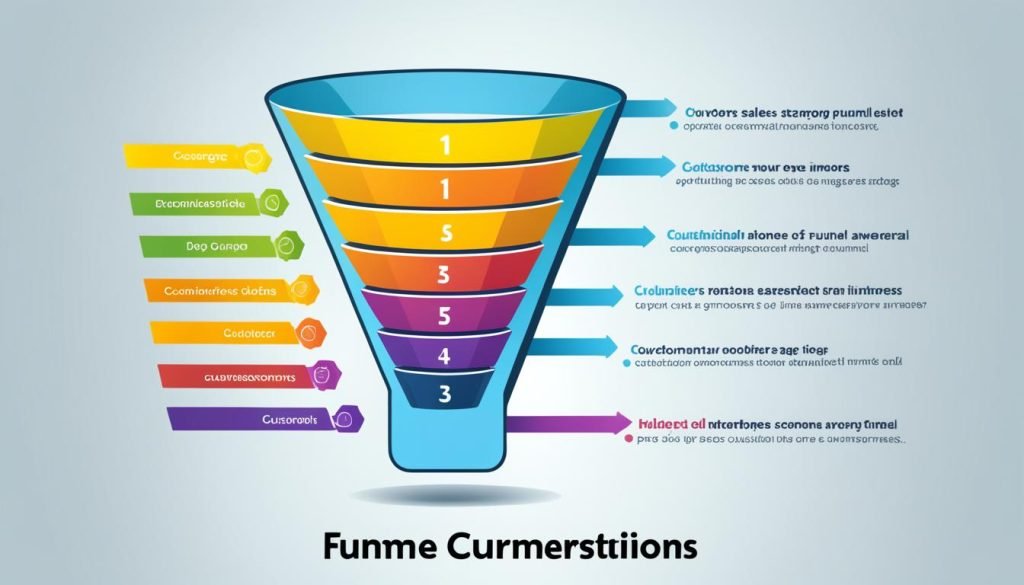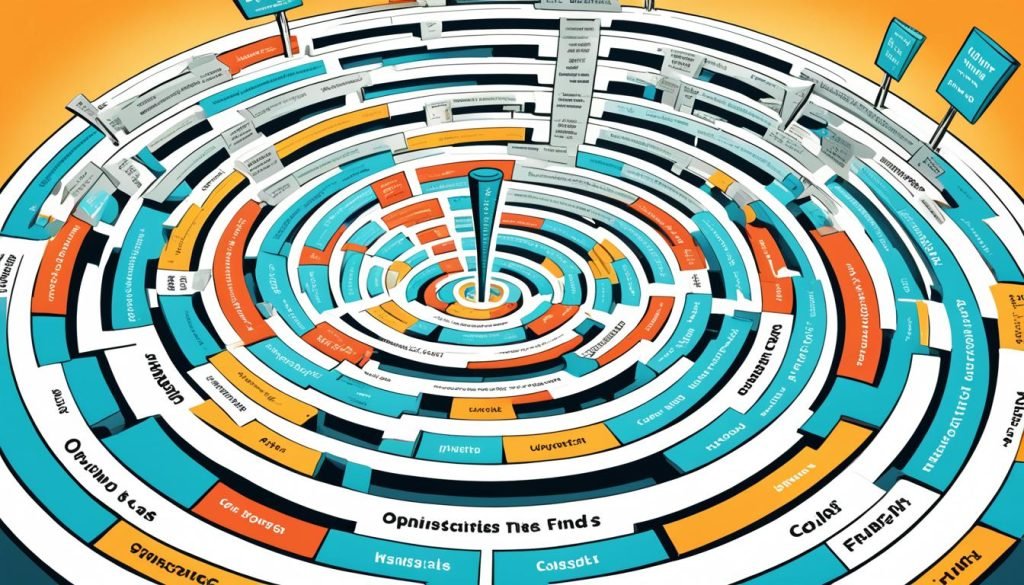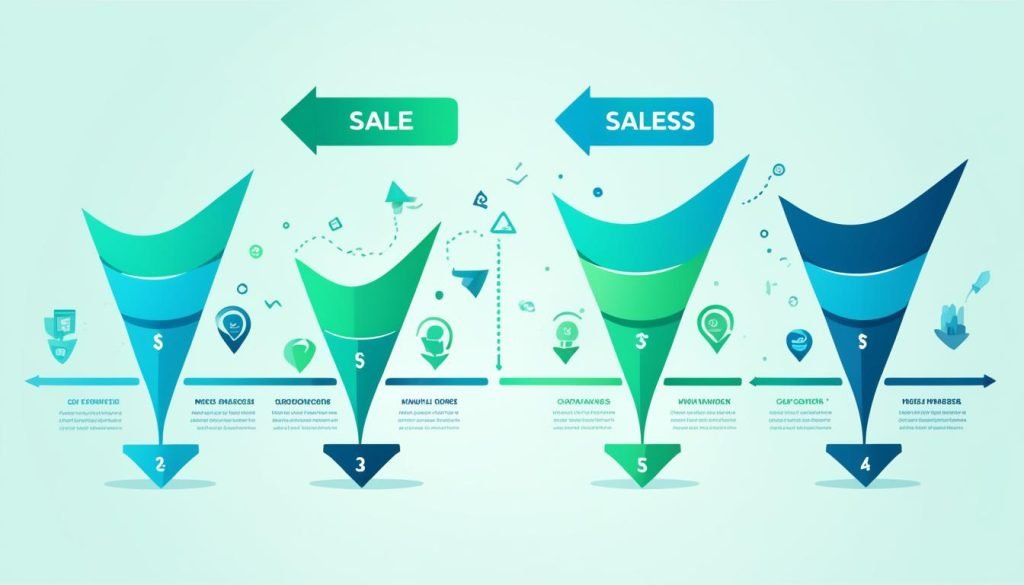Picture this: You’re walking through the mall. You see a beautiful pair of shoes in a store window. They make your heart race with joy. So, you walk into the store full of excitement to try them on.
This experience is a lot like a sales funnel. Customers start with many options, but over time, they choose one. We’ll look at the sales funnel process and its importance for businesses. It’s key to get this process right.
Key Takeaways:
- A sales funnel guides potential buyers from first seeing a product to buying it.
- Every stage of the funnel helps turn people interested in a product into buying customers.
- By knowing and improving your sales funnel, you can sell more smoothly and effectively.
- Designing a specific sales funnel for your business and tracking its success is vital for sales growth.
- Learning from successful sales funnels can help you make yours better.
What is a sales funnel?
A sales funnel shows how possible customers journey to buying a product or service. It often begins with many people interested and ends with only a few buying. The process moves them through stages like awareness, interest, and action, getting closer to a sale at each step.
Understanding the Sales Funnel Process
Let’s take a made-up example to explain. Imagine you sell skincare stuff online. First, customers hear about you through ads, social media, or friends. They learn what your products can do for them.
They then look deeper. They might check your site, read blogs, or watch reviews to see if it fits their needs. This is the interest stage.
After that, they compare your products with others. They look at quality, price, and ingredients to choose the best value. This step is about making a smart buy.
Happy with their choice, they get more involved with your brand. This could be joining a loyalty scheme or following your updates. It’s a chance for you to make them feel part of your brand’s family.
Finally, they’re ready to buy. They choose what they want, go to checkout, and pay. This completes the funnel, making it a sale for you and what they hope is a great buy for them.
But the story doesn’t end there. If you keep them happy with great service and offers, they could come back. This is how you turn a buyer into someone who loves and talks about your brand.
How Sales Funnels Work
Sales funnels help customers move from just knowing about you to loving what you offer. At each step, you need special ways to talk to them and show why your product is worth it.
You use all sorts of methods to do this. Content online, emails, and ads that follow them, offering deals tailor-made for their needs. This is to answer their questions and remind them about you till they buy.
Getting this right means knowing who you’re talking to and what they like. You keep checking how well you’re doing and fixing things to keep getting better. A good sales funnel makes selling easier and keeps your business growing.
Why are sales funnels important?
Sales funnels are key for B2B success. They turn leads into customers efficiently. They show where prospects are in the buying path. This lets businesses adjust their marketing and sales to each prospect’s stage.
They also help map the customer’s journey. By studying funnel stages, businesses see the buyer’s path. This helps them find areas to get better and make sales tactics right for their audience.
Sales funnels make managing customer relationships better. Every step in the funnel is clear, letting businesses track each customer interaction. They use this to make conversations with clients more personal. This boosts customer happiness and loyalty.
Optimising a sales funnel is easier with the right strategy. Using tech and metrics, businesses spot and fix any issues in their sales flow. This means making smarter choices, improving their methods, and increasing revenue.
In short, sales funnels are vital for B2B success. They offer clear structures for sales, help in mapping customer journeys, understand customer needs, and improve customer interactions. They also make it easier to spot sales flow problems and solve them.
Sources:
- “The Ultimate Guide to Sales Funnels” by Salesforce
- “The Importance of Sales Funnels in B2B Marketing” by HubSpot
- “Mastering the Art of Sales Funnel Optimization” by Neil Patel
The stages of a sales funnel
In a sales funnel, customers go through six main stages before they buy. Knowing each stage helps you turn leads into sales. Let’s look at each stage:
- Awareness: Prospects find out about your brand. They might see you on social media, ads, or hear about you from friends.
- Interest: After knowing your brand, they get curious about your products. This happens when they visit your website or engage with your content.
- Evaluation: Prospects start comparing your products with others. They look at reviews or ask for more info to make the best choice.
- Engagement: They start to interact with you more. They might subscribe to your blog or join your webinars.
- Action: This is when they make a purchase. It could be a one-time buy or a service subscription.
- Retention: After buying, you want to keep them happy. Offer great support and deals to encourage more purchases.
By mastering the sales funnel steps, you can enhance your marketing and close more sales. Use smart lead generation and nurturing tactics to guide potential clients. This way, you’ll boost conversions and grow your business.
Sales Funnel Stages
| Stage | Description |
|---|---|
| Awareness | Prospects become aware of your company and offerings. |
| Interest | Prospects show interest in your product or service. |
| Evaluation | Prospects evaluate your offerings and compare them to competitors. |
| Engagement | Prospects actively engage with your company and marketing efforts. |
| Action | Prospects take action and make a purchase. |
| Retention | Customers continue to engage and potentially make repeat purchases. |
The benefits of a sales funnel
Sales funnels make the customer journey better. They tailor the sales strategy just for the customer. This makes the customer more likely to buy again. Prospects are guided through a pathway. Here, your messages and offers meet their needs closely. This boosts the chances of them buying again.
Using a sales funnel helps you understand what customers want. As they move from one funnel stage to the next, you learn about their likes and dislikes. This helps in making your marketing better. You then create content that people really connect with.
“Implementing a sales funnel has helped us uncover valuable insights about our customers. We are now able to create highly personalized marketing campaigns that speak directly to their needs and interests.” – Sarah Johnson, Marketing Director at XYZ Company
Additionally, sales funnels make managing customer relationships better. They help you stay in touch with leads in a structured way. This builds stronger bonds with them. It also opens doors for selling more products or services to them.
Sales funnels also let you make your sales process better over time. You look at important numbers at each funnel step. This means figuring out what works and what doesn’t. Then, you tweak your approach as needed.
To make your sales funnel work even better, try sales automation software. This tech does the repetitive work for you. This gives your sales team more time for important tasks. It also lets you track how well your funnel is doing.
In conclusion, a smartly crafted sales funnel can transform your sales and marketing. It does this by making the customer journey personal, truly understanding what customers need, and enhancing relationships. Plus, it helps make your approach to sales smarter. This leads to more sales, better sales efficiency, and a save on time and resources.

| Benefits of a Sales Funnel |
|---|
| 1. Personalized sales strategy |
| 2. Increased customer lifetime value |
| 3. Better understanding of customer needs |
| 4. Improved customer relationship management |
| 5. Sales funnel optimization |
How to create a sales funnel
A sales funnel is a way to lead people from being interested to buying. It has steps that can turn leads into loyal customers by knowing your audience, engaging with them, and offering the right content. Let’s look at how to build a great sales funnel:
Analyze Your Target Audience
Start with knowing who your audience is and what they want. Do market research, gather data, and make customer personas. This helps you understand their needs and tailor your sales funnel to meet those needs.
Create Compelling Content and Marketing Campaigns
After you know your audience, create content they will love. This can be blogs, videos, or social media posts. Use SEO and keywords to pull them in. Also, run campaigns that speak directly to them, building your brand as you go.
Engage with Leads through Various Channels
Use different ways to reach out to leads and guide them through the funnel. This might mean sending emails, being active on social media, hosting webinars, and following up personally. Keeping in touch and sharing helpful info builds trust and keeps them interested.
Evaluate Lead Qualification
Check how interested your leads are as they move through. Use scoring or other methods to see who’s ready to buy. Focus more on those who are most likely to become customers.
Provide Targeted Content and Incentives
Once you know who’s the most interested, offer them special content and deals. This could be discounts, free trials, or exclusive offers. Give them content that directly solves their problems and shows your product’s value.
Continue Communication to Retain Loyalty
Keep in contact after they buy to make them stay. Send newsletters, give them special deals, and keep active on social media. This turns them into fans who will recommend you to others.
Building a sales funnel is about knowing your audience, making content they love, guiding them through the funnel, qualifying leads, offering the right deals, and keeping them happy. Put the effort in, and you’ll see more sales and a growing business.
Measuring and optimizing a sales funnel
After setting up your sales funnel, it’s key to check its success and improve where needed. Keep an eye on important numbers at every step. This lets you see what’s working and what isn’t. Here’s what you should look at:
- Conversion Rates: Keep track of how many people are moving through each funnel stage. This shows if your messages and deals are hitting the mark.
- Sales Revenue: Figure out how much money your funnel is making. It’s a solid way to know if it’s worth it.
- Customer Lifetime Value: Look at how much each customer spends over time. It tells you the real value of your sales funnel.
- Customer Retention Rate: See who keeps buying from you. It’s a sign that your efforts to keep customers happy are working.
With these metrics in hand, dig in. Find ways to make your funnel work even better. Here are some tips:
- Improve Lead Qualification: Sharpen how you pick leads. This way, you’ll spend time on those who are likely to become customers.
- Enhance Content and Messaging: Always tweak what you say and show to meet customer needs. This can boost how many people buy from you.
- Streamline the Sales Process: Spot where your sales get stuck and fix it. A smoother experience means happier customers.
- Implement Sales Automation Software: Use tools that can do the boring tasks for you. This can make your sales more efficient and help you track your progress better.
But remember, this is an ongoing job. Keep a close watch on your data. Try new things. Use what the numbers tell you to keep your sales funnel top-notch.
| Optimization Strategies | Benefits |
|---|---|
| Improve lead qualification | Attract high-quality prospects |
| Enhance content and messaging | Increase engagement and conversions |
| Streamline the sales process | Improve efficiency and customer experience |
| Implement sales automation software | Automate tasks and track metrics more effectively |

Sales funnel examples
Many companies use successful sales funnels, like Twilio does. Twilio is a communication API provider. They use targeted content and personalised messages to lead prospects through their funnel.
Twilio figures out what their potential customers need. They then send content that helps with these needs. This way, they guide prospects from just looking to becoming loyal customers.
“Our sales funnel allows us to provide a seamless and tailored experience for our prospects. By understanding their unique requirements, we can deliver the right message at the right time, increasing the chances of conversion and customer satisfaction.” – Twilio representative
Tricentis, a software testing tool, has a great sales funnel too. They use customer data to make marketing campaigns that hit the mark with their audience. By knowing their audience well, they keep them interested at every step.
This keeps Tricentis relevant and helps turn potential customers into loyal ones.
“Our sales funnel enables us to connect with our prospects on a deeper level. By understanding their challenges and aspirations, we can deliver customized solutions that meet their needs. This personalized approach has significantly improved our conversion rates and customer satisfaction.” – Tricentis representative
These cases show good sales funnels convert leads into customers. They stress knowing your audience well and offering the right content. Nurturing leads this way can turn them into happy, loyal customers.
Conclusion
Sales funnels play a key role in boosting sales and marketing. They guide the journey from lead to customer. By using the right tactics at each step, businesses can win more sales. A sales funnel explained is your road map to attracting your ideal customers.
In B2B, sales funnels help cut down on sales cycle time. They let businesses tailor their approach to what customers really want. Understanding your customers and taking them through the sales funnel step by step is key.
To create a strong sales funnel, start by getting to know your audience. Then, draw them in, work to keep their interest, and deliver the content they need. Tending to those customers after they buy is just as important. This keeps them coming back.’
Keep an eye on how your sales funnel is doing and improve it over time. Watching what works and making changes helps your business grow. Key areas to watch are how many leads turn into sales, money you make from those sales, and how long customers stay with your brand.
Look at companies like Twilio and Tricentis for inspiration. They show how a focused plan and tailored messages lead customers to buy. Good sales funnels, supported by the right content and messages, can really work.’
To wrap up, sales funnels are a must for turning leads into buyers. With a smart sales funnel plan and regular tweaks, your sales can soar. It’s all about matching what you offer with what customers need, every step of the way. That leads to sales and grows your business.’
| Benefits of Sales Funnels | Measuring and Optimization | Sales Funnel Examples |
|---|---|---|
| Structured framework for converting leads | Track conversion rates and sales revenue | Twilio |
| Personalized customer journey | Analyze customer lifetime value | Tricentis |
| Increased understanding of customer needs | Optimize lead qualification | |
| Improved customer relationship management | Enhance content and messaging | |
| Maximized revenue and sales productivity | Implement sales automation software |
References
Explore these valuable resources to learn more about sales funnels:
1. “What Are Sales Funnels? How Sales Conversion Funnels Work for B2B” by Close
Sales Funnels Explained, Sales Funnel Process, Sales Funnel Stages, How Sales Funnels Work
“What Are Sales Funnels? How Sales Conversion Funnels Work for B2B” is a detailed guide. It explains sales funnels in B2B settings. It details each stage, shows their importance, and gives tips for better sales.”
2. “What is a Sales Funnel? The Definitive Guide” by Pipedrive
Sales Funnel Stages, Sales Funnel Strategy, Marketing Funnel Tips
Pipedrive’s guide is a deep dive into sales funnels. It covers stages and strategies well. The guide offers tips to improve your funnel strategy and get more leads.
3. “The Beginner’s Guide to Sales Funnel Management” by Salesforce
Sales Funnel Optimization, Creating Sales Funnels, Sales Funnel Examples
Salesforce’s “The Beginner’s Guide to Sales Funnel Management” is a starting point. It shows how to build and make your funnel better. It includes real examples and talks about lead nurturing, automation, and making funnels work best.
These resources will help you understand sales funnels better. They can be a key to success for your business.
Additional Resources
If you’re keen on learning more about sales funnels, we have some great resources for you. They offer valuable tips and advice:
- The Ultimate Sales Funnel Strategy (Guide + Examples) by HubSpot
- The Essential Guide to Conversion Rate Optimization by Crazy Egg
- The Science of Sales Funnel Optimization by Neil Patel
These links cover many aspects of sales funnels, such as their stages and how to make them work better. They offer expert advice, helping you understand and improve your sales funnel for better results.




